20 years of satellite network construction and maintenance
Now it’s hard to believe, but some two dozen years ago - it was considered a great success if “long distance” could get through the first time. Broadband Access? Wireless Internet? A communicator in everyone’s pocket? This is after all from somewhere from the "worlds of Noon" Strugatsky, I guessed right?
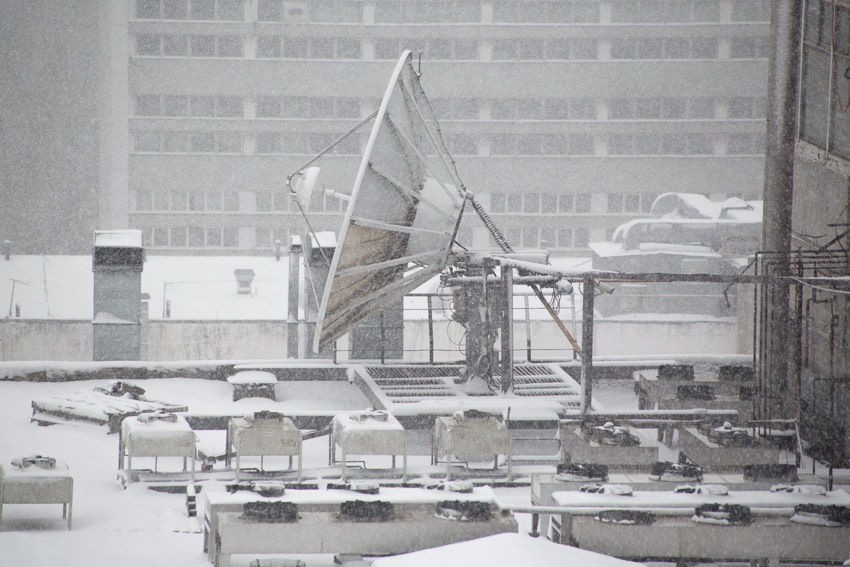
The very first antenna installed on the roof of the hangar of the All-Russian Energy Institute. In which I still found the Mig-21 aircraft standing there and experimental stands simulating lightning discharges.
And in 1995, SFMT Ltd, an unknown company (which later grew up in Golden Telecom), began the construction of a “superimposed” (that is, working in parallel with the national All-Russian) communication network.And as the main transport - it was decided to use their own satellite communication channels. The first Moscow-Vladivostok channel - at launch, it had a speed of only 128 Kbps (kilobits!). However, through this channel, telephony (including access to the Sovintel’s World Access Card service, which was quite popular at that time ), and a data transmission channel for the RussiaOnline modem pool (SOVAM Teleport, a half-forgotten legend) were transmitted.
I’ll tell you about the teleport, and its main components. Caution, traffic : many photos.
Within a fairly short time, the network has grown channels to such large cities as Khabarovsk, Tyumen, Ufa, Syktyvkar, Novosibirsk, Arkhangelsk, Nizhny Novgorod, Volgograd ... They did not forget about the smaller ones: Chelyabinsk, Perm, Cheboksary, Komsomolsk-on-Amur, Kazan, Lipetsk, Tula ... Following the appearance of the channels, high-quality “voice” services also arrived without dial-up problems, and data transfer services. Then another direction began to develop: the provision of channels and services to large Clients located “on the edge of geography”: logging in Siziman Bay, oil production in the vicinity of Purpe and Lensk ...
Meanwhile, the development of terrestrial (and above all, fiber-optic) networks did not stand still. Optics went on and on. Some satellite stations at the nodes turned off and dismantled, some became centers ("hubs", "teleports") of their own satellite subnets.
Today's story is about one of the oldest satellite teleports on our network.
So, get acquainted: Moscow, Krasnokazarmennaya, 12.
Here are three more antennas and equipment in containers at our facility:

The first one from the picture above is “in reserve” to pick up channels in case of any unforeseen situations. The last time in this role - she worked in the accident of the Express-MD1 satellite. The
mirrors are large:the larger the diameter of the mirror, the greater the antenna gain. Think of a regular flashlight: with the same light - the one with the larger mirror will shine further. A large gain (or, which in this case is the same - high sensitivity) is very important for satellite communications.
The leftmost antenna with the photo above is 11 meters in diameter. For scale, look at the windows of a building, or the cellular antennas on a brick dock near. This antenna is the largest here (and according to unverified rumors - this is almost the only antenna in the world of this diameter installed on the roof, and not on the ground).
In general, one of the largest antennas in Russia, with a diameter of 64 meters, is located on the Bear Lakes. Where we have another teleport:

Here in this old photo - the luminaries of satellite communications Nikolai Nikolaevich Vinogradov and I am against the background of this antenna.

This antenna (Andrew, 7.3 m in diameter) is the legacy of Kominkom-Combelga. We brought her here from Cow's Shaft. They drove, without dismantling, at night. They blocked the movement along the entire route, checked that everything in size fits in with a small margin (wires did not hang, gas pipelines and other details did not interfere), put on a trailer - and dragged with a traffic police tuple. They just got to the building, but the last 50 meters were a real circus. But they managed, of course.
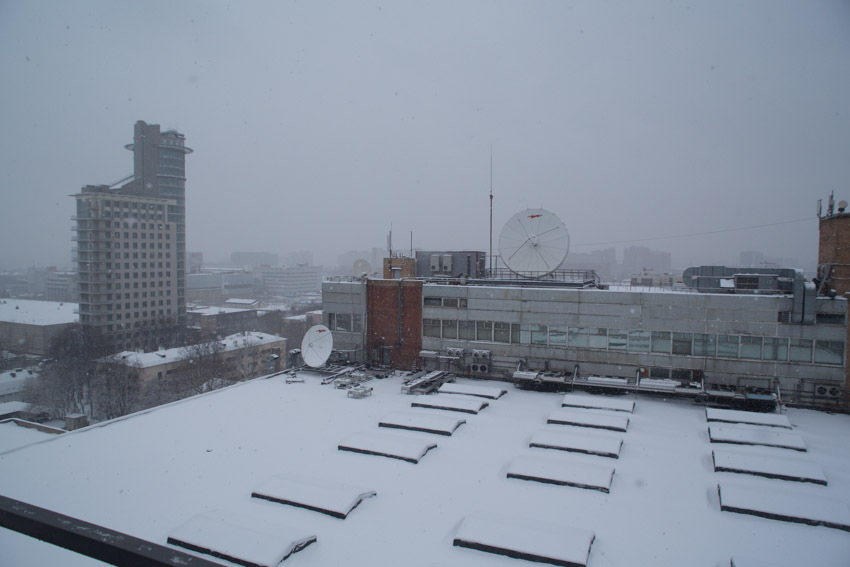
"The very first" from below and the antenna "from the Cow Shaft"

This antenna (Vertex, diameter 7.2m) - the second one appeared here. And at first she worked in the C-band, and then she was successfully remade to work in the Ku band. This is a bit more complicated than a similar alteration of the “television” plate: it was necessary not only to change the irradiator, but also to “drag” the geometry of the mirror surface again.
This is one of the two local antennas equipped with a satellite auto-tracking system.
For antennas with a wide radiation pattern - this "eight" falls entirely inside the antenna beam. And for antennas with a narrow diagram (that is, antennas with large diameters of mirrors, remember?) - often an exact adjustment of the position is already required in accordance with the current position of the satellite. This is done with the help of these drives:
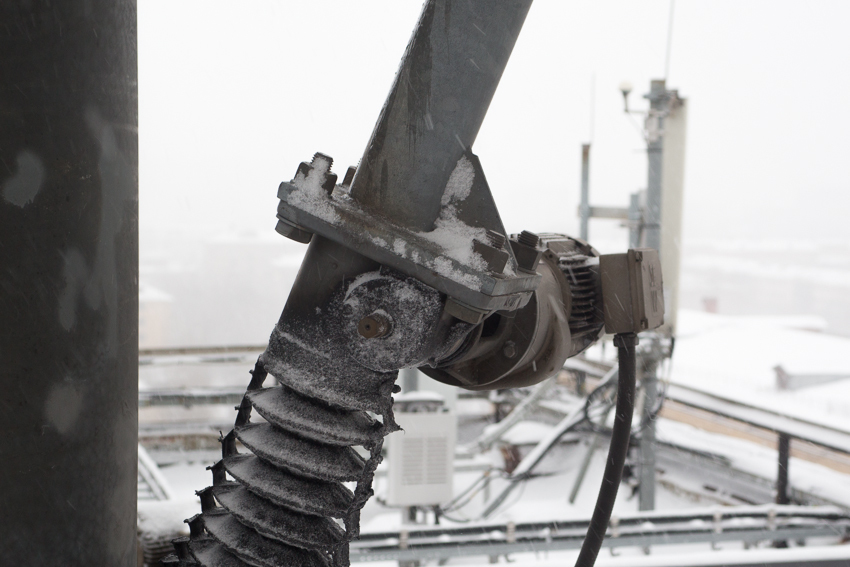
Automatic tracking regularly evaluates the level of the signal coming from the satellite, the current position of the antenna, and, if necessary, turns on the drives that move the mirror in two directions (“in azimuth” and “in elevation”). Thus, the antenna always remains aimed at the point in the sky where the satellite is now.
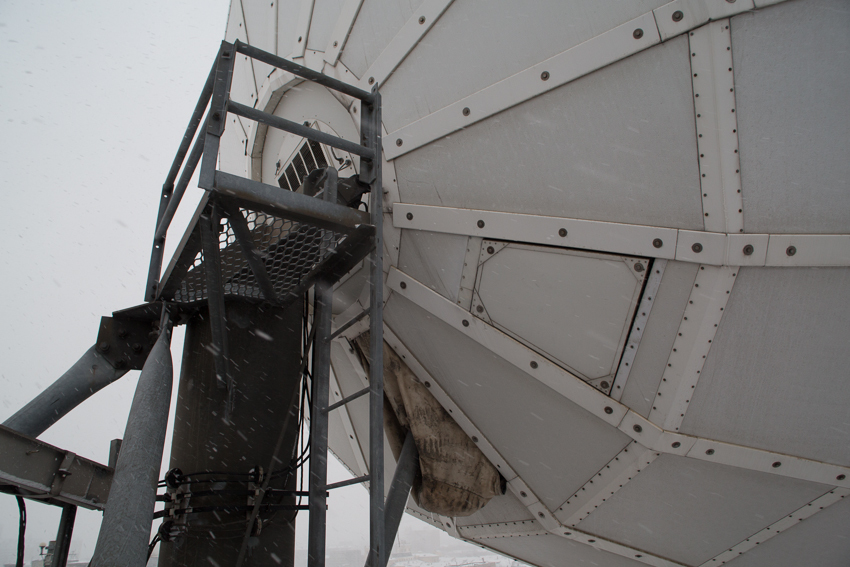
The antenna has an anti-icing system that prevents the accumulation of ice and snow on the mirror and irradiator. Now it’s about -4 degrees Celsius outside, it is wet snow. Water flows from a plate, here:

A small box in the center of the photo is a weather sensor. It is then necessary that the conditions for the formation of ice arise only in a narrow temperature range: from minus 5 to plus 5 degrees. Well, if there is rainfall, of course. At temperatures above 5 degrees Celsius, everything simply drains, and at below minus five - the snow is dry, it just slides off the mirror. Power of antenna heaters - 25kW; so that the correct operation of this small box - can significantly reduce energy bills.
Now carefully look right here to the very top:
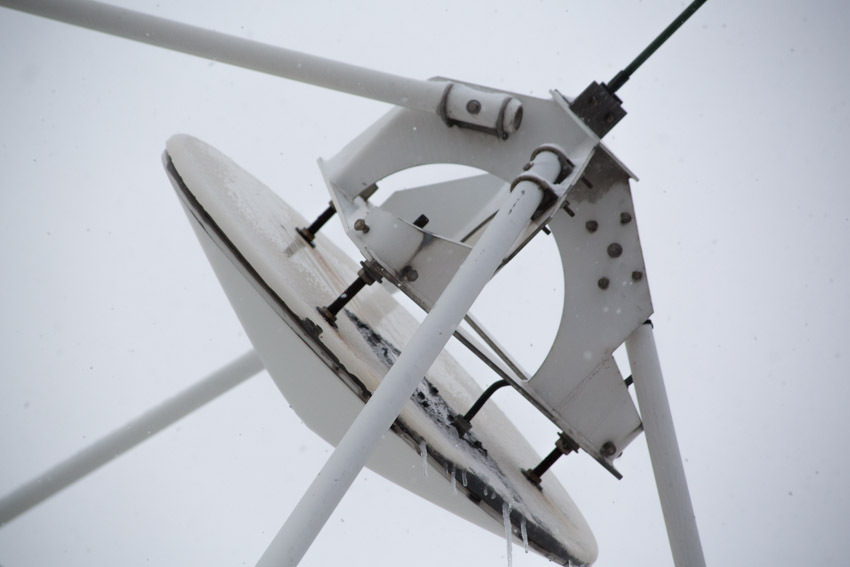
Not a single cable goes there - this is not a receiver yet, it is a counter-reflector; indispensable attribute of the so-called "Two-mirror antenna."
Two-mirror antennas are more complicated in design, but they, compared with the “single-mirror” ones, are much higher than the so-called. "Surface utilization" of the mirror.
Below, right in the center of the mirror itself is the antenna feed:
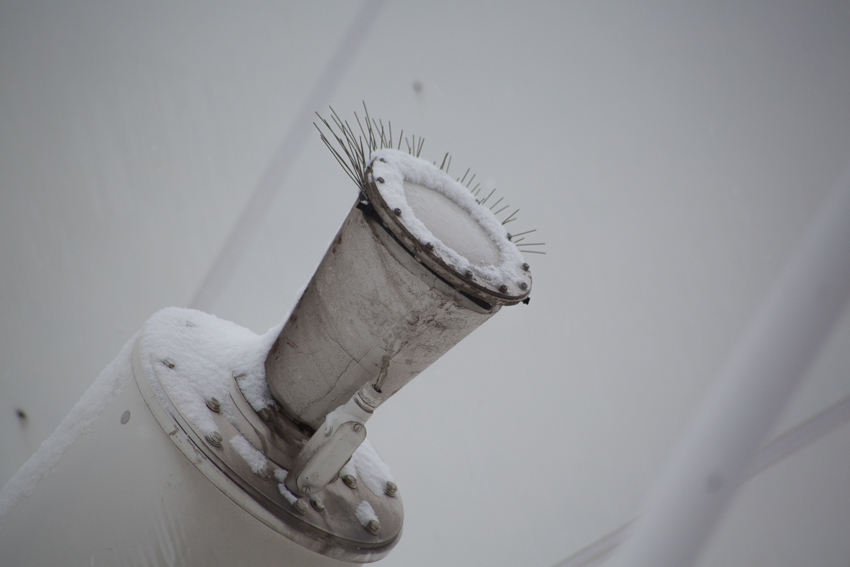
In general, the feed was not so “fluffy” in the original, but we had to modify it.The fact is that its output is closed by a radio-transparent film, which has the same magical attractiveness for ravens. Not understanding such simple safety rules as “stay out of focus with the transmitter turned on”, they sit down happily and begin to peck the film. The irradiator and the entire waveguide path are under constant overpressure of specially dried air. As you know, water and moisture are electrically conductive, and moisture entering the waveguide is equivalent to getting a decent piece of metal there. And if the crow with its armor-piercing beak pierces a hole in the film ... In general, the crow has a chance to intervene in someone else's banking transaction. But with these “hairs” the problem is almost completely solved. Almost - because anyway, the film is very seductive for them.
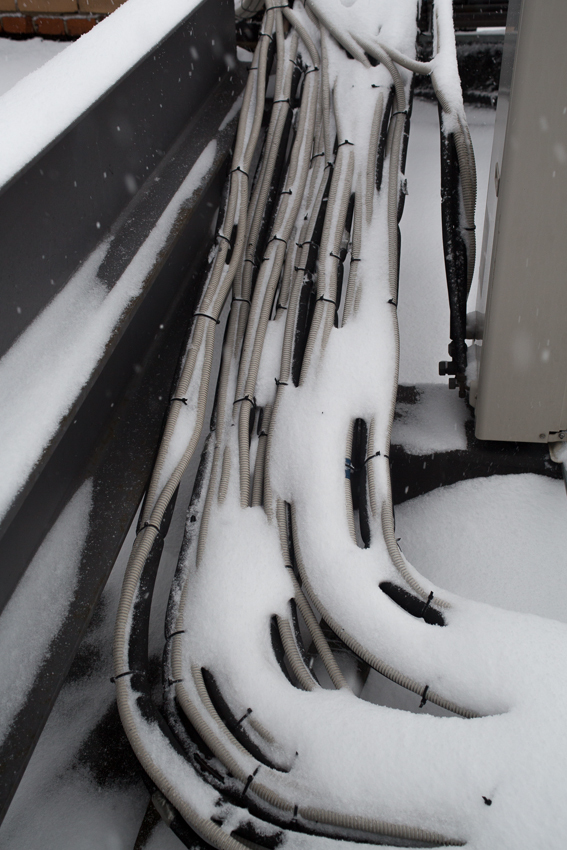
Quite a lot of cables are suitable for the antenna: radio-frequency, power, control, control ... The
“under-mirror cockpit” of the antenna - an inside look:
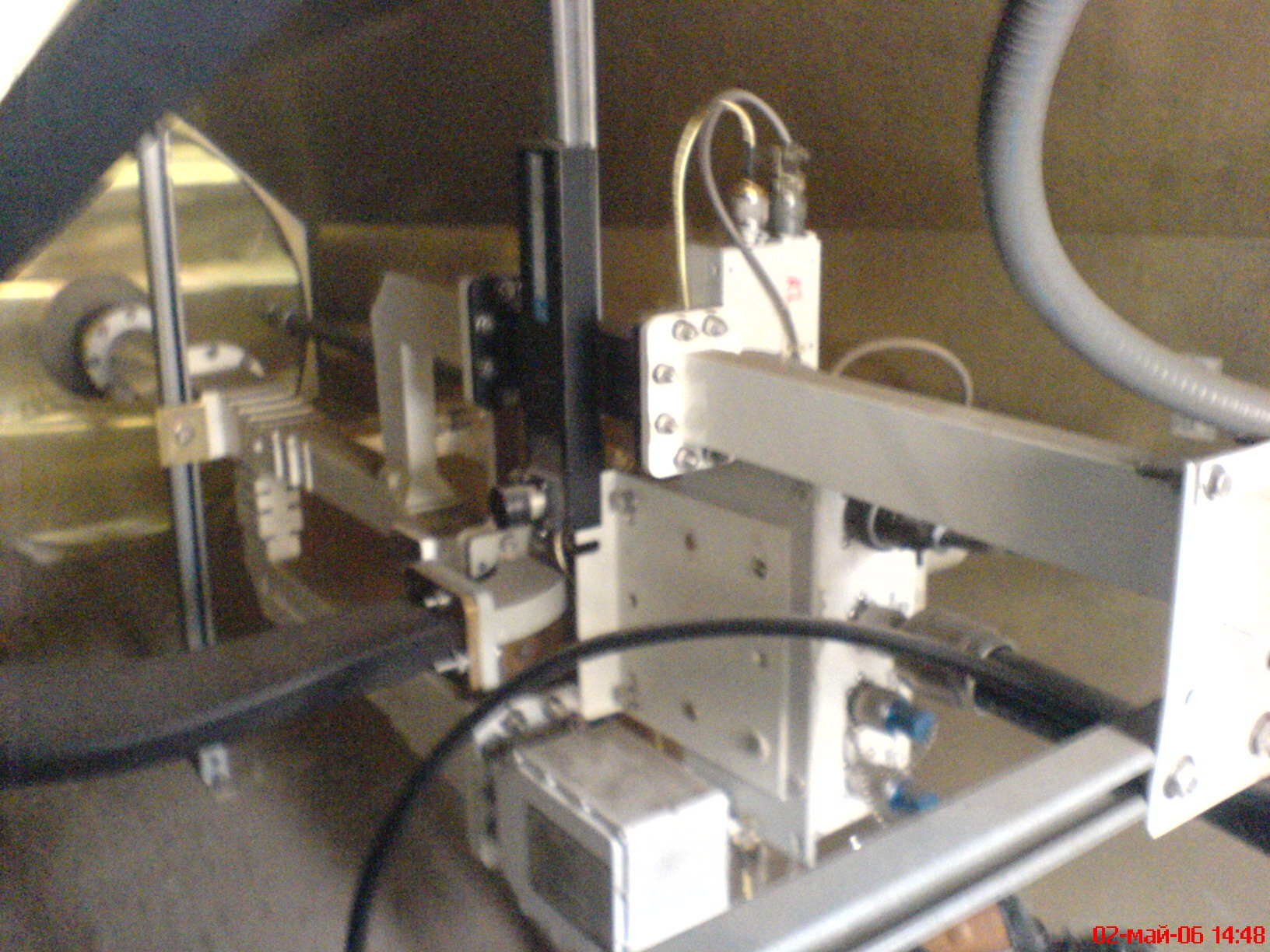
“Pipeline” down - the receiving part, one of the LNAs (a rectangular box at the bottom) is visible. Thick cable - output signal from the LNA redundancy switch. A “pipeline” in the middle is a transmission path. A flexible waveguide (left) is suitable for it. And straight and forward is the antenna feed.
High-frequency cable (above) and the “semi-rigid” elliptical C-band waveguide (below): The

waveguides are also flexible:
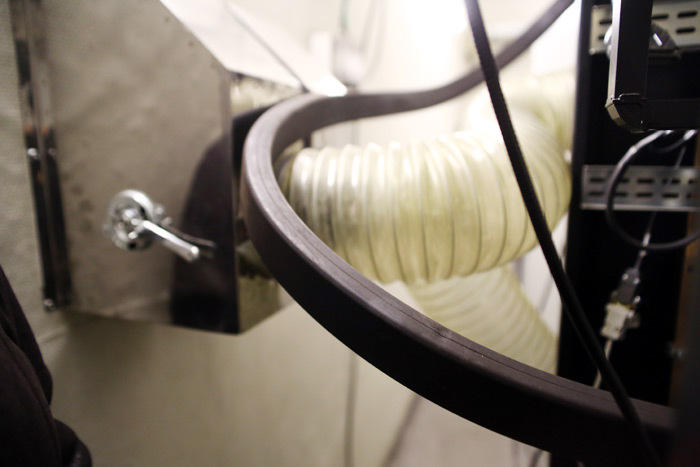
Compared to rigid or “semi-rigid” ones, they have noticeably more loss. But the use of flexible waveguides (or sections of flexible waveguides between two rigid) - increases the simplicity and ease of installation.
Radio equipment, as well as antenna control systems, are located in containers near the antennas:
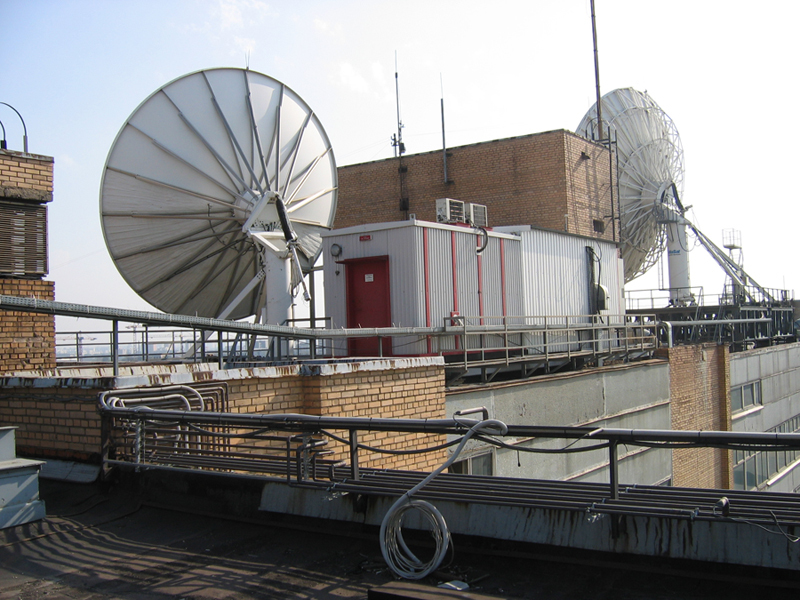

From the entrance we are met by a "system of solid-state power amplifiers with 100% reserve." The power amplifier (aka “transmitter”) - in fact, and allows the antenna to go on air.
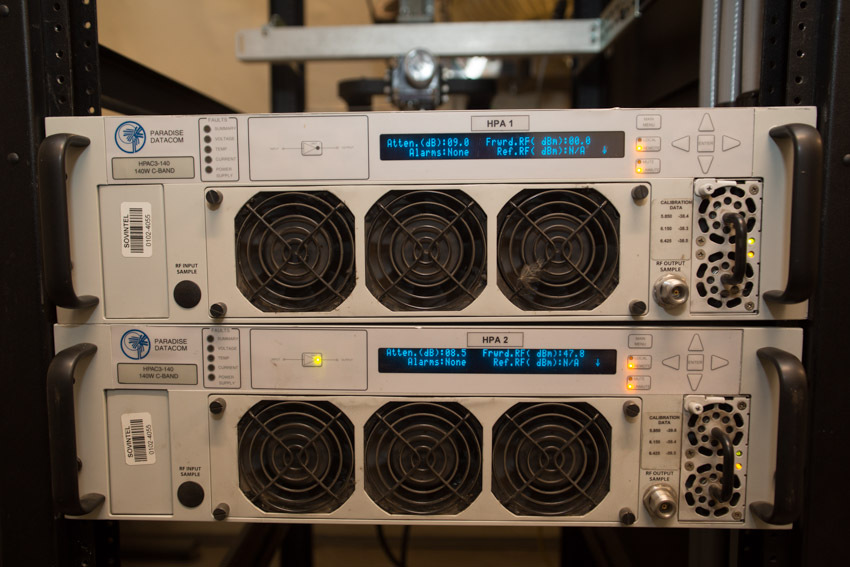
Another transmitter, but not “solid state” (transistor), but a tube one .
Believe me, it was not installed for the sake of the famous “warm tube sound”! Amplifiers on transistors - most recently they began to catch up with amplifiers on lamps in their parameters. For example: transistor above - has a maximum power of 140W, and tube below - 700W. With the same dimensions and approximately the same consumption - you must agree, the difference is very significant. The advantage of transistors is greater linearity. None of the amplifiers operate at maximum power, due to the occurrence of non-linear distortions in it (and this is death for the “phase modulation” used in satellite communications). To obtain a known linear mode - a transistor amplifier can be "dispersed" no more than half of the maximum power. Tube - no more than a quarter. But still: half of 140W is noticeably less than a quarter of 700W.
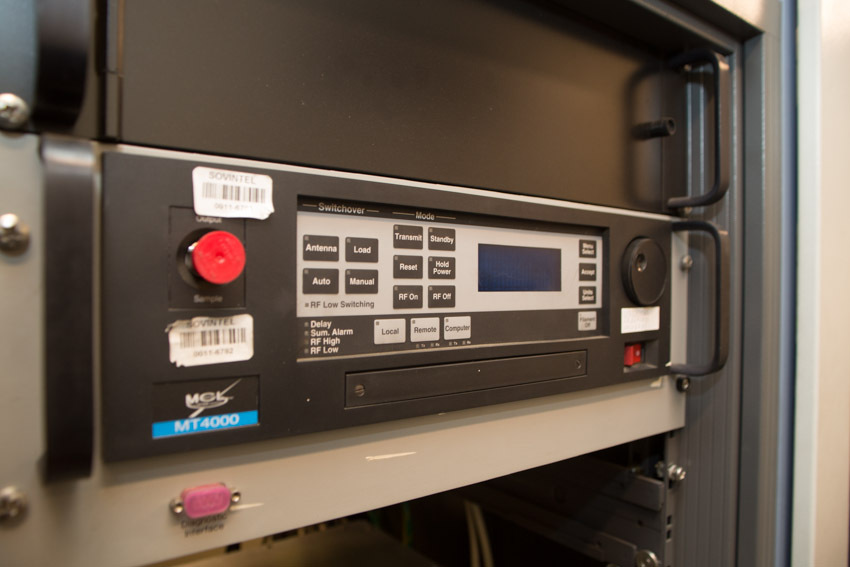
This is what the entire rack looks like: The
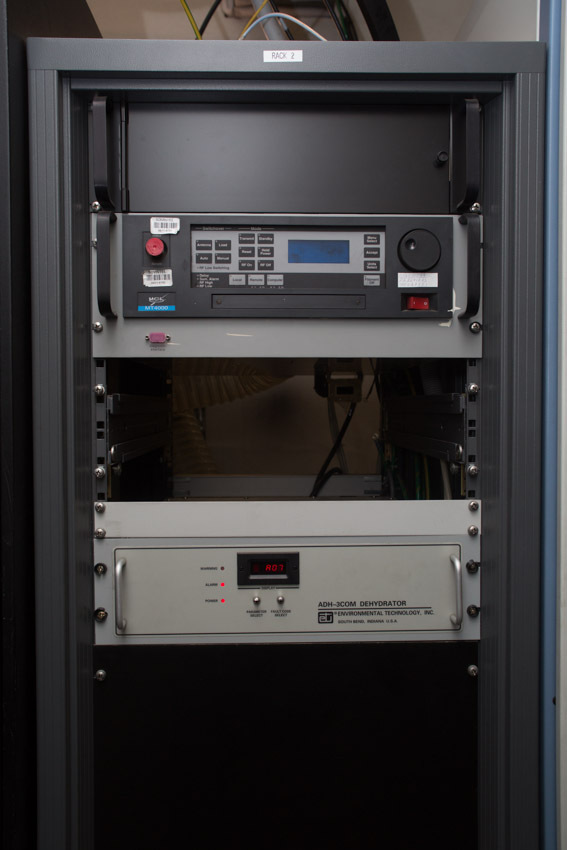
gray thing under the transmitter is an air dryer that maintains the waveguide paths in good condition.
And now the rest of the container equipment:

These are the air ducts of the transmitter cooling system:

Do you see the handle on the box? Also our “know-how”: it is a proprietary winter-summer mode switch. It’s cold in winter, and the equipment also loves room temperature. Well, yes, you can put a heater, but why? Turned the knob - and bask. And in the spring the handle spins to another position; and the air conditioners say “thank you, master!”
Here is the control unit for the air distribution of the waveguide paths. Feed adjustment - made by rods with balls (bottom). You can estimate the air consumption (and at the same time - the presence of a strong leak) on the scales past which the balls "float":
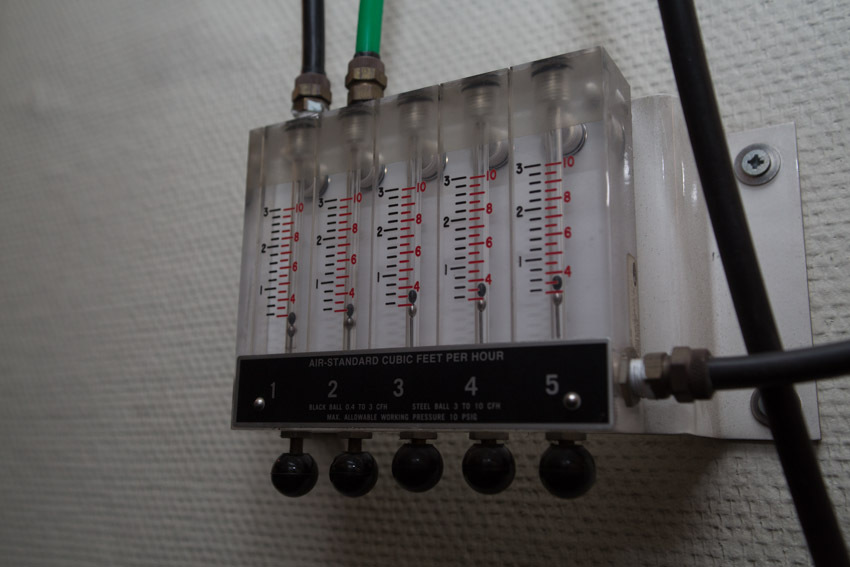
These are the IF cables coming from the modems in the control room , located four floors below. On large nodes - we use a circuit with “IF70 / 140MHz”, it is simpler and easier than a circuit with “IF L-Band”. Each pair of cables is the reception and transmission of one transponder.
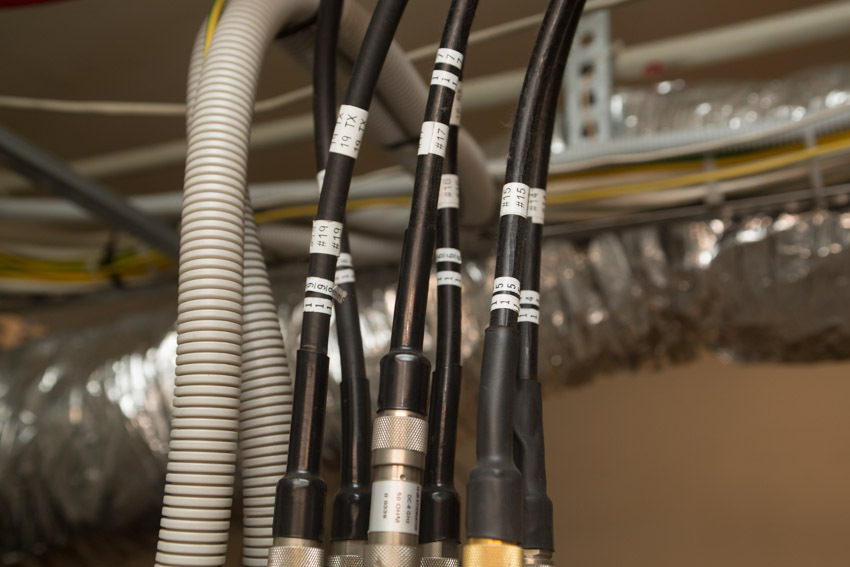
Rear post:

And one more:
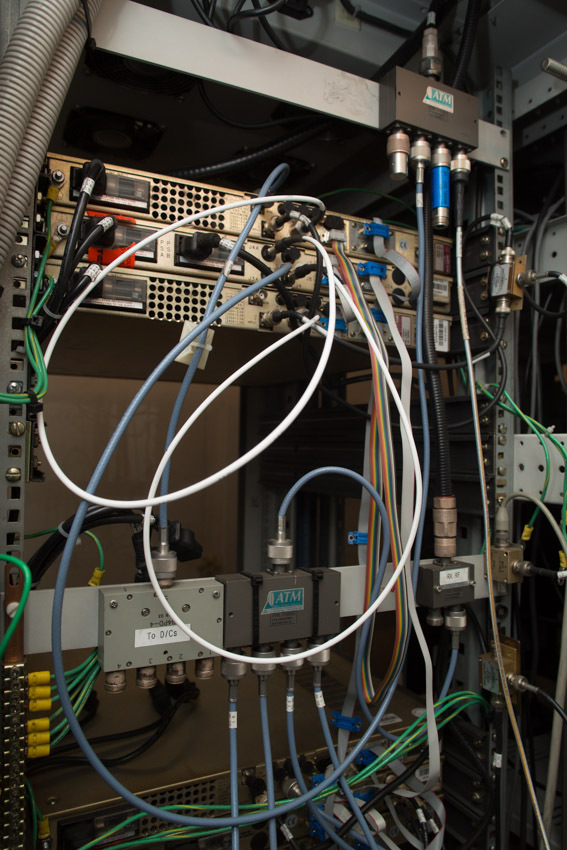
A thick corrugated cable is the input signal from the low-noise antenna amplifier. Why is the amplifier “low noise”? The theory of radio engineering says: "the noise of the entire system - cannot be less than the noise of its first amplification stage." To detect a received signal, a certain signal-to-noise ratio is required. And the less intrinsic noise the system adds - the less power it will take from the satellite to correctly transmit the same signal.
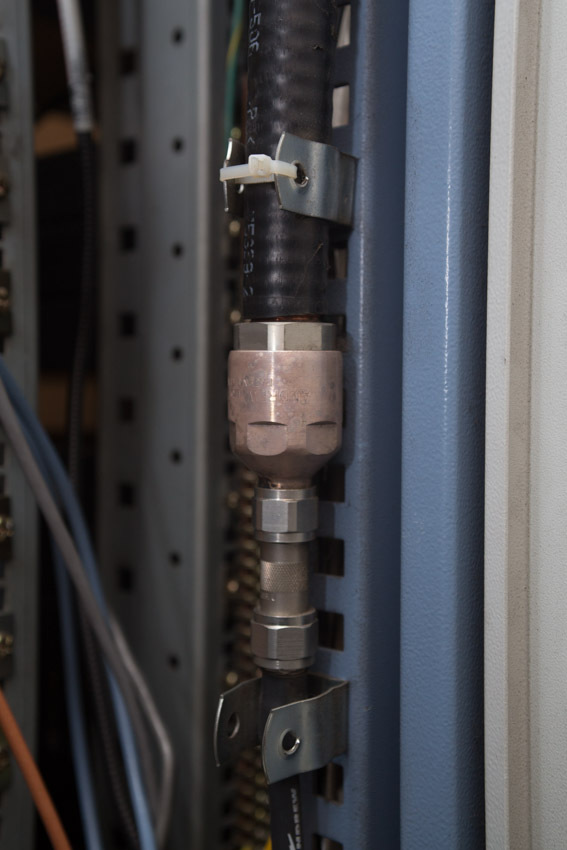
High-frequency cable from the LNA antenna.

High-frequency cable from the LNA antenna, and an RF splitter.

Splitters - divide high-frequency signals between converters of different transponders.
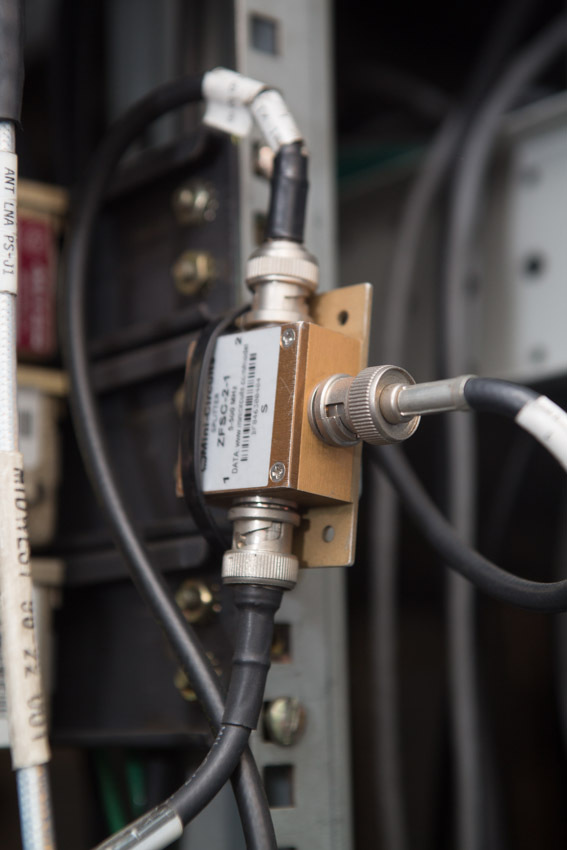
One more, but - already for the IF signals.
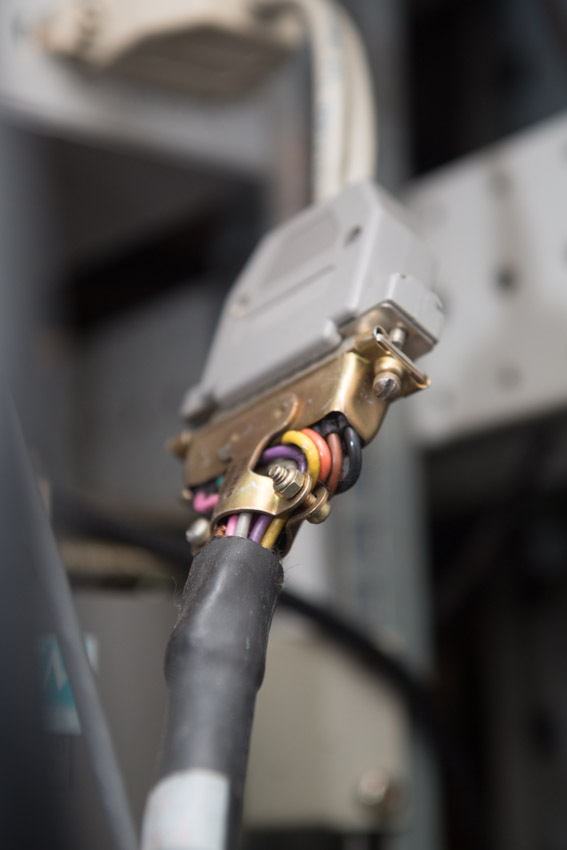
LNA redundancy power and control cable
Two racks in the distance are our first transmitters. Klystron, C-band, with a power of 3 kW each. I will say right away: at full capacity - they never worked. But after the next gnawed film, it is very itchy hands to turn them on, and fry a couple of “crochets” on the fly:
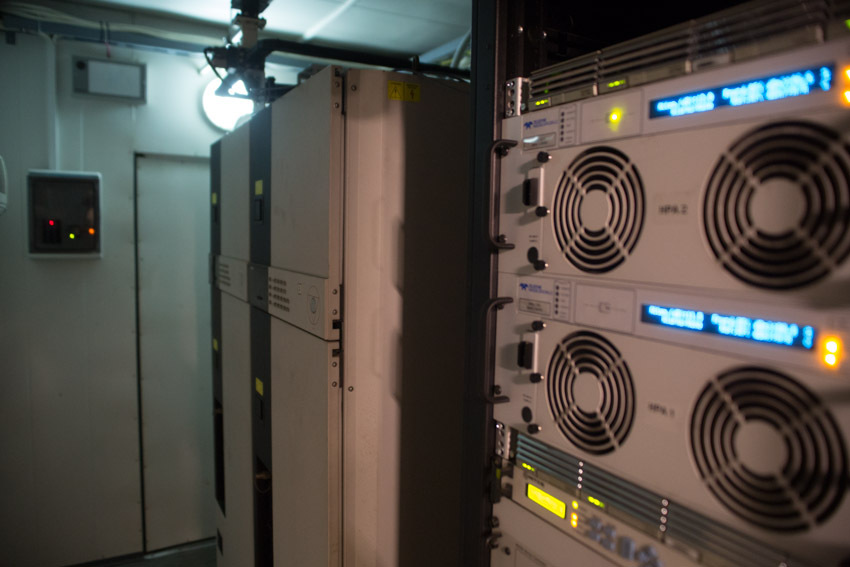
On top - a switch and redundant waveguides; and load for a “spare” transmitter. Load with forced cooling: if the “spare” transmitter operates “in hot standby” (that is, it emits in the same way as the “main”), all its power is dissipated in the load.
A fan is used for cooling:

For high-power transistor transmitters - the so-called commonly used “Semi-hot” reserve: “spare” transmitter does not emit. In this case, a switch is installed in the backup system, at the same time switching both the waveguide output of the transmitter and its coaxial input. It looks like this: The

round little thing on the left is the electric drive of the switch.
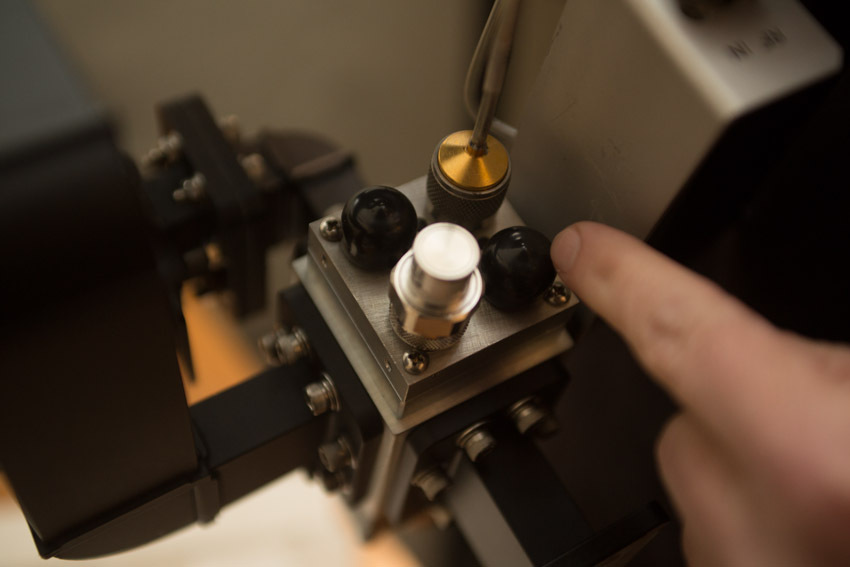
Below - the "waveguide" part of the switch, above - "coaxial". To the input of a non-working transmitter - a load is connected (silver, in the foreground), which does not allow the transmitter to catch interference from the air.
A connector through which signals are sent to the switch that control its switching, and from which the backup system receives information about the current position of the switch.

This device is in the rack, in operation:
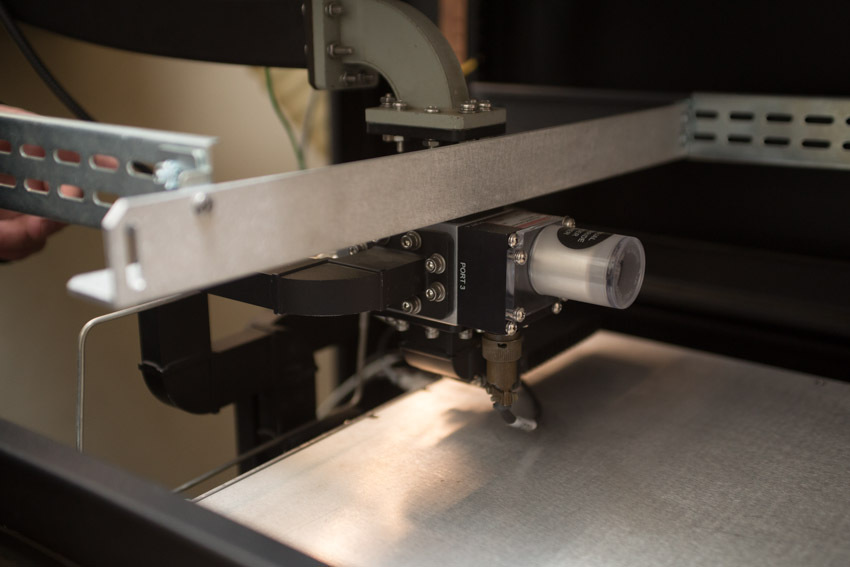
Now we will return to the roof again and go around the antennas:
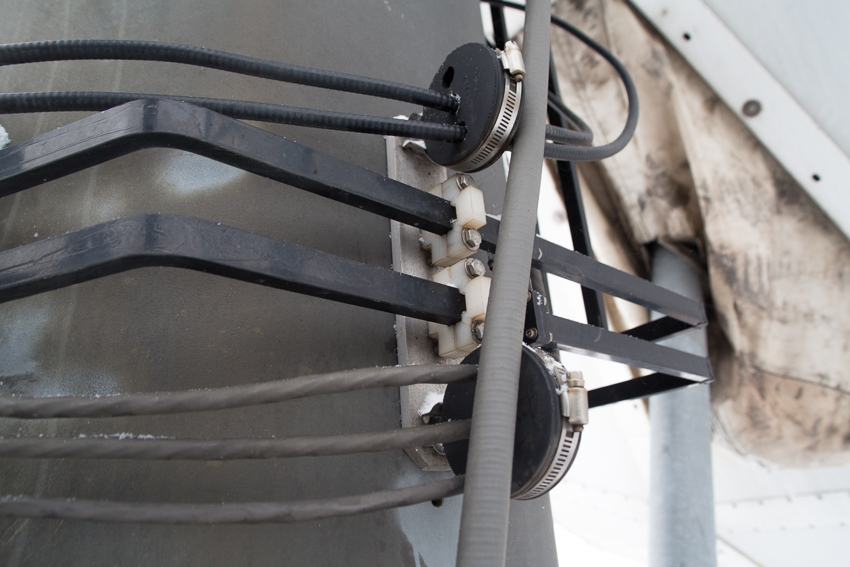
HF cables (above), Ku-band “rigid” waveguides (rectangular in the middle), LNA control and power cables.
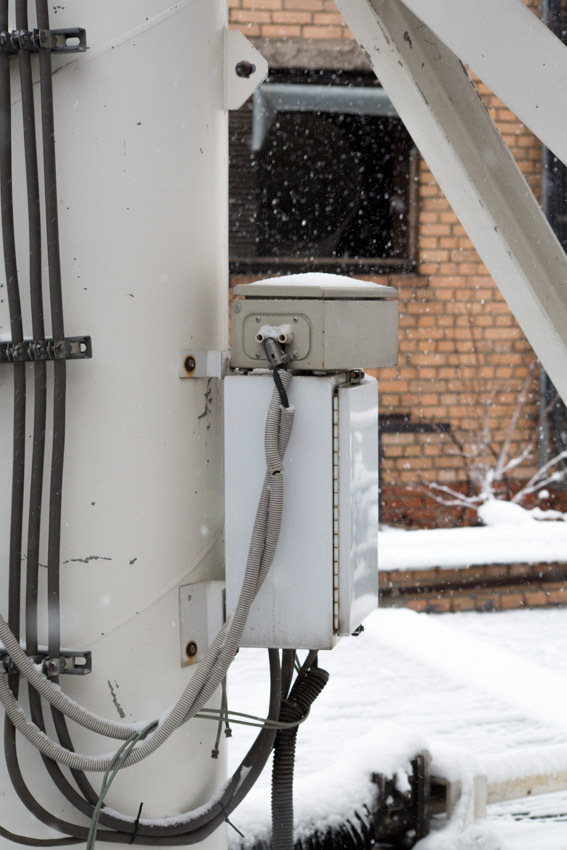
Junction box on the “foot” of the antenna.
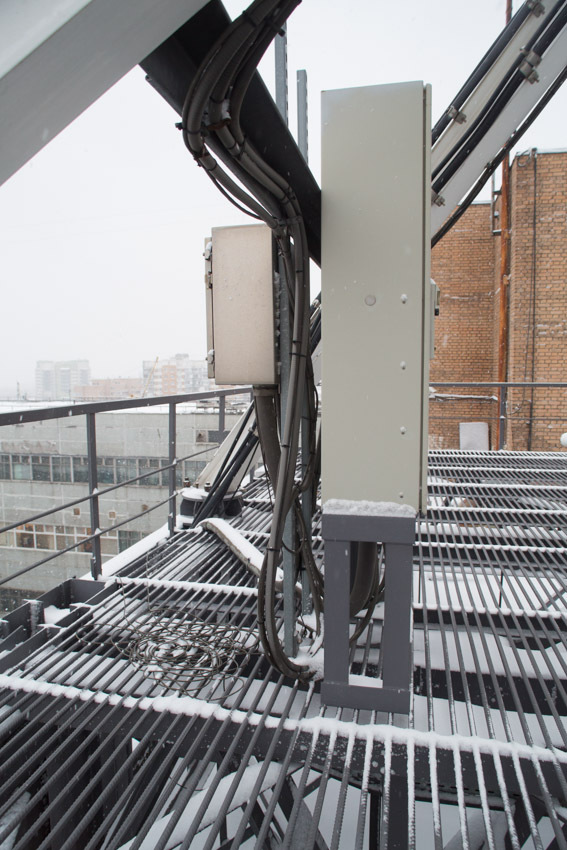
The same thing, but in a more solid form of an “electrical cabinet”.
In such boxes and cabinets, power cables for antenna equipment, auto tracking systems, and antenna anti-icing systems are wound up. Well, it’s necessary - there is a very useful thing inside: a socket for connecting power tools, lighting, etc.
If 220volt is supplied to the antenna, we almost always put similar boxes or shields near the antenna. The additional costs are small, and a lot of amenities during construction and operation.
Now the next construction.

This is a C-band antenna, so it’s so big. Naturally, you should not even try to use such an antenna without an auto tracking system.

The cable, the "braiding" mirror - the power of the anti-icing system (on this antenna - it is made in the form of "heating mats")
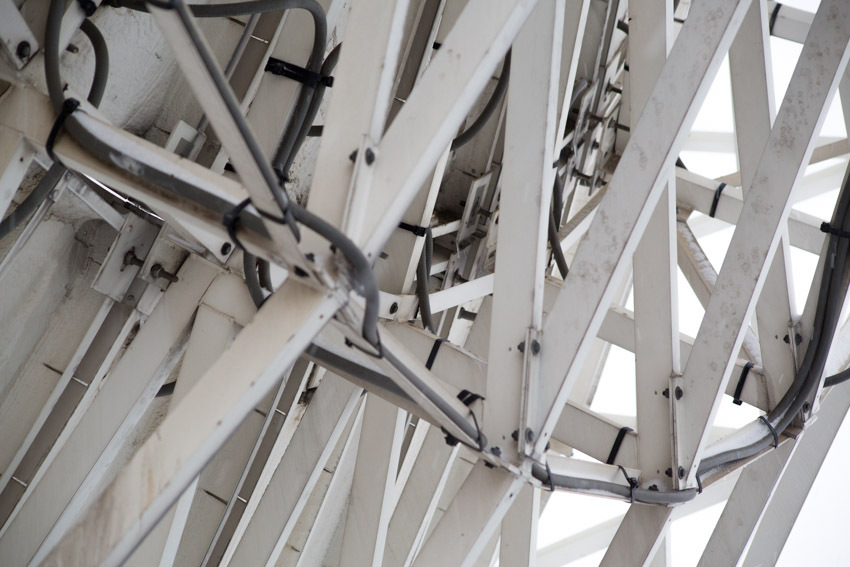
A separate story is connected with the installation. Such antennas naturally gather on the ground. In our case, the assembly was carried out here, between these buildings. From the edge of the mirror to the walls was no more than half a meter.
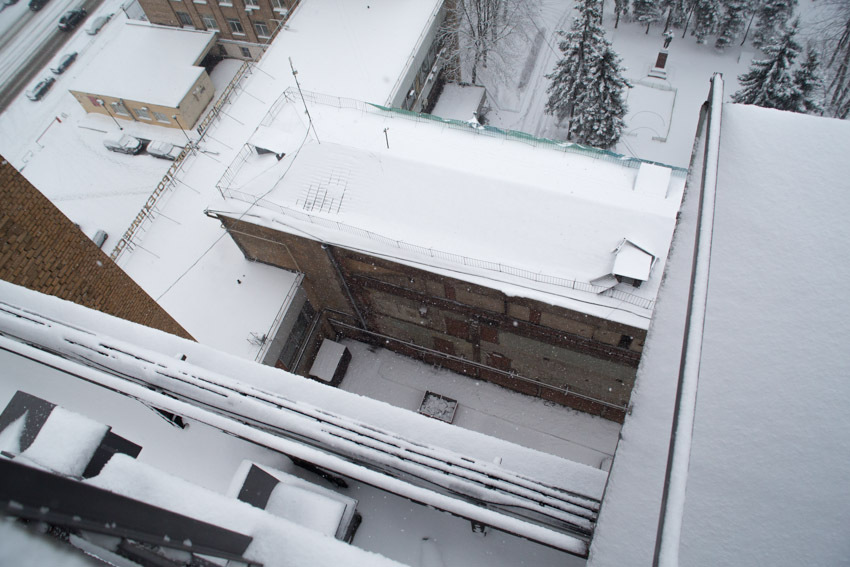
Then she was lifted by a crane. So:
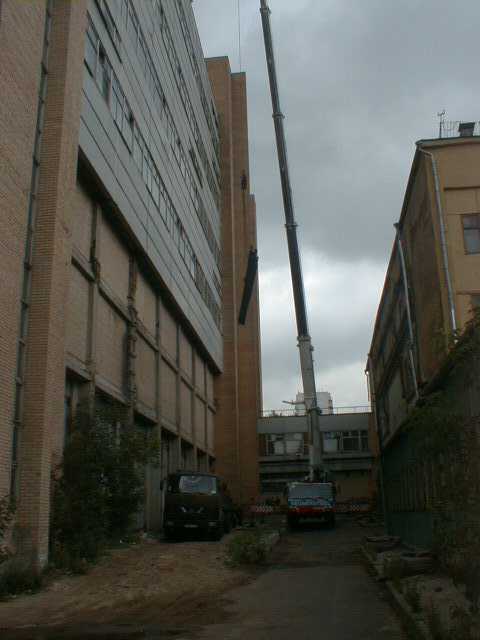
Naturally, the crane operator behind the edge of the roof did not see where to put it, but it was necessary to get on the metal "ears", with a tolerance of a couple of millimeters.
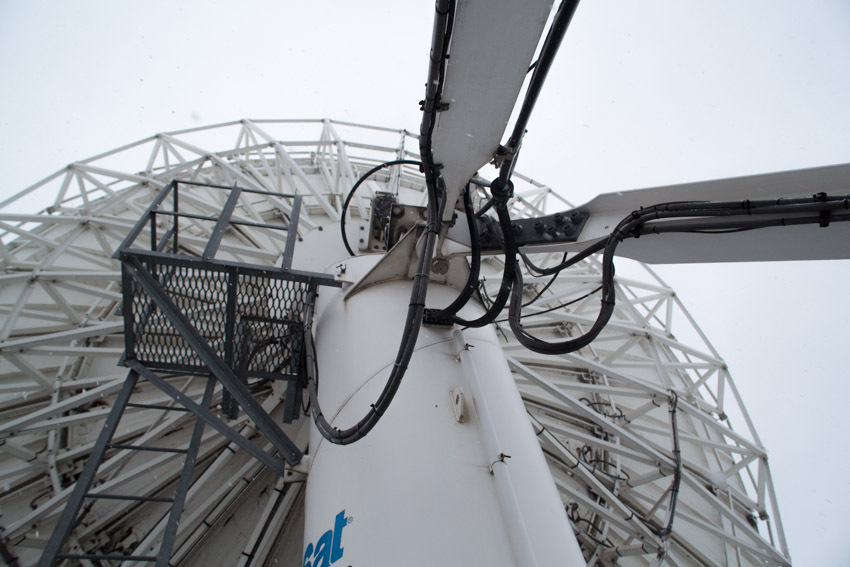
Like this:
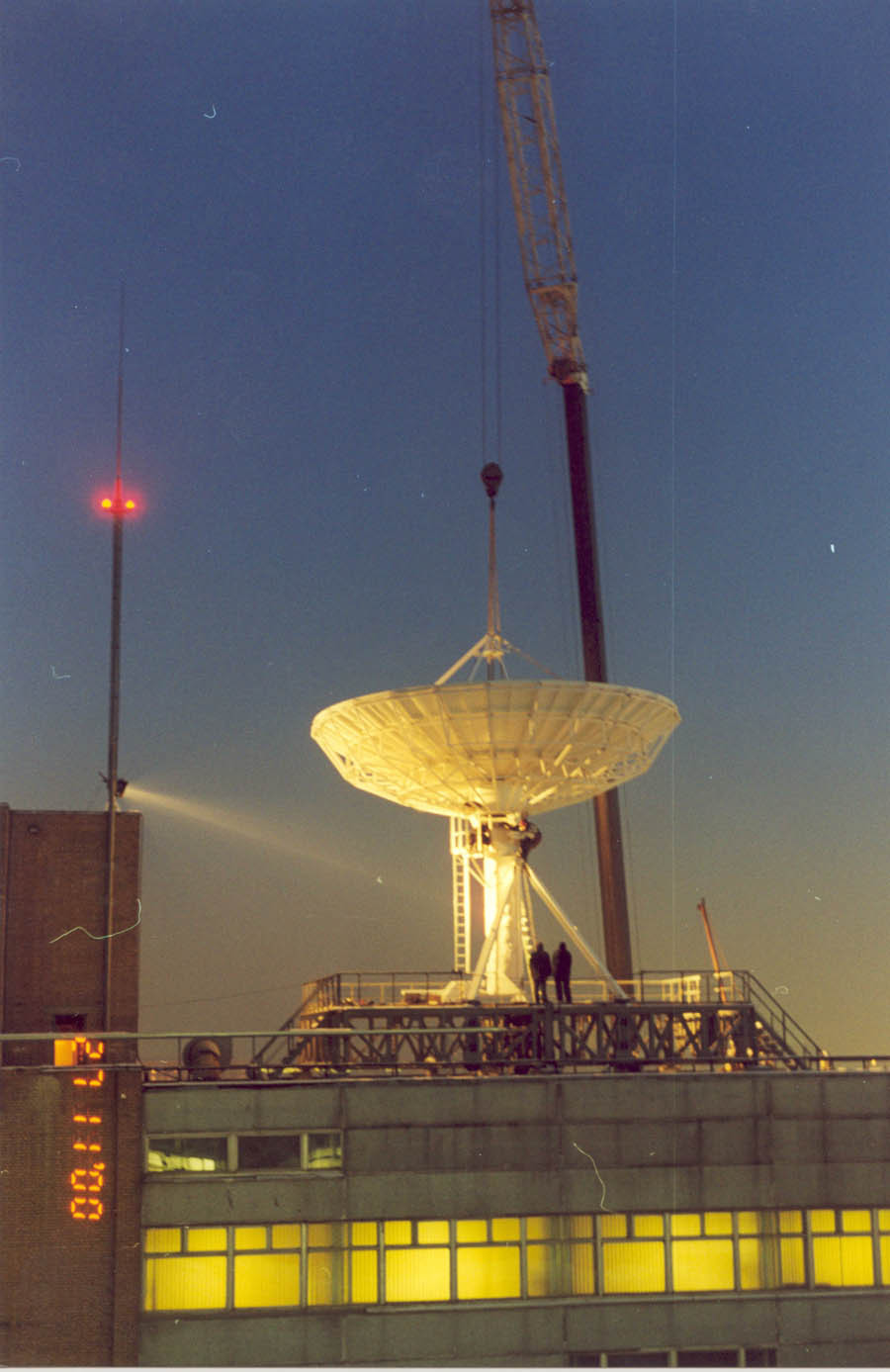
The operation was the hardest. And as I said, this is almost the only antenna in the world of this diameter, installed not on the ground, but on the roof of a high-rise building.
The irradiator of this antenna. See how his little birds chewed? Yes, it took them almost 15 years to do this; but I say: the beaks of the raven are armor-piercing.
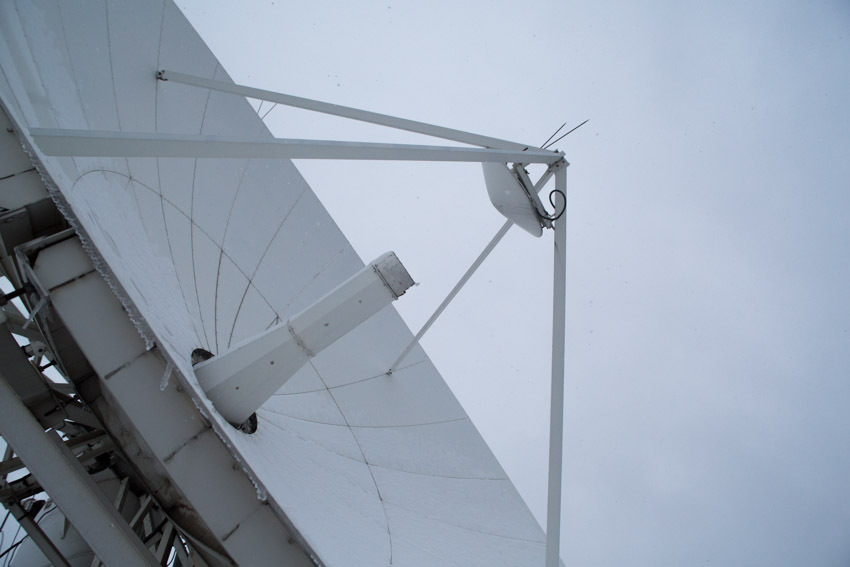
And there, the edge is mute too. This is either the crows again got to the film, or the remainder of the previous radiolucent film. I'd like to believe in the latter; however, after a couple of days it will be necessary to carry out maintenance work. And here it’s also interesting. Serving such an antenna, and in particular its irradiator, is not an easy task. Ahead - the abyss of 12 floors, remember? You can, of course, turn the antenna sideways, towards the roof. But the fact is that the auto tracking drive does not allow you to quickly move the antenna. A 90-degree rotation will take several hours; and the drive is not intended for such significant turns.
Therefore, we again had to invent a little.
"Native" drive - disconnects:
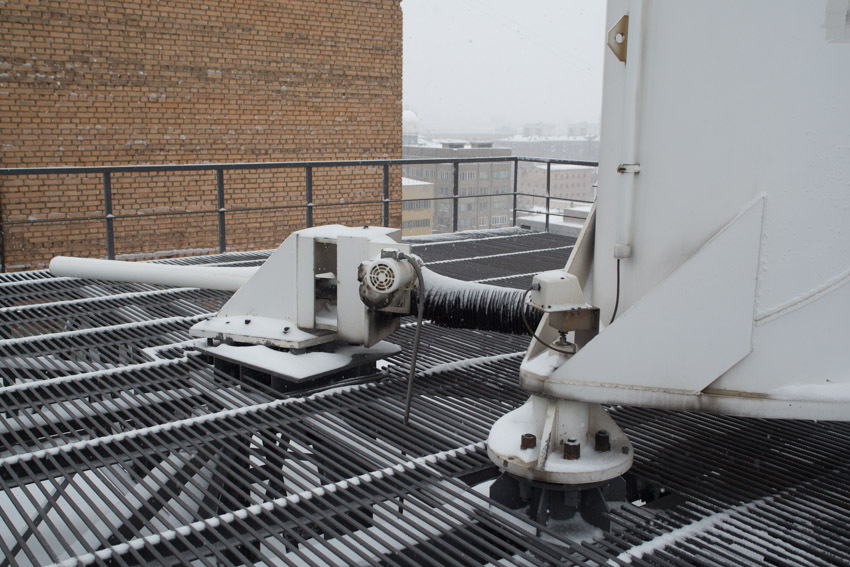
Instead of it - a self-made temporary one is put: small, but very fast. He turns the antenna to the desired angle in just five minutes.
So that the antenna is not curled up by a random gust of wind, while the main drive is disconnected, and while the whole antenna is kept on a “fast home-made” - the antenna column is fixed to the “temporary anchor”:

One of the “ears” of the antenna enters the eye at the top, for which the standard drive clings. The whole structure is fixed with a finger (hanging at the bottom of the eye). Everything, gusts of wind are now not afraid of us.
On the side of the antenna, we made a special “tipping” platform.

We turn off the transmitters, turn the antenna to the site with an additional drive, “tilt” the site into a mirror - and now the irradiator is easily accessible for any work, repair and maintenance. Simple, reliable, convenient and safe!

- Why do you need such a large and expensive facility?
So that communication is also where there are no land lines. Or they are, but of small capacity, poor quality, or very expensive. And there are still many places in Russia: even large cities like Petropavlovsk-Kamchatsky, Magadan, Anadyr, Norilsk do not have land channels (of sufficient capacity). What can we say about the villages in Yakutia or the Far East, or about gas production complexes in Siberia. And this is not only for cellular communications: ipvpn or Lan2Lan is very popular among the same drillers; primarily for monitoring complex objects such as rigs. And you can talk via skype too ... Yes, satellite channels cannot compare with bandwidth optics: a satellite channel with a speed of 10 Mbps is considered very wide. Can I do more? You can, we have channels of 100 and 200 Mbit each. But this, first of all, is a very expensive pleasure.
- On each base station it is put on ZSSS?
Not necessary. If there is a group of BSs that are interconnected by terrestrial channels, then for the work of the whole group one ZSSS is enough; how this is done, for example, here in Bovanenkovo (http://habrahabr.ru/company/beeline/blog/247773/).
But sometimes it’s easier and cheaper to build two earth stations than to try to lay a land line between two points. For example, Keperveem Airport - this, according to Wikipedia - is only 32km from Bilibino. But to stretch the channel from there to Bilibino is practically impossible, and therefore we have another ZSSS there.
- How does satellite communications work?
A satellite is a kind of mirror that looks at a certain territory: the so-called "Service area". And in principle, any two stations located inside this territory can communicate with each other. Actually, this is the main charm of satellite communications: distances are not important to her. A correspondent station can be located on a neighboring house, or maybe thousands of kilometers from the "center"; for satellite communications - it makes no difference.
Transmitting station - broadcasts a signal to a satellite. Receiving - catches it, decodes, and transfers the received data to the user. If the communication system is bidirectional (and not broadcast, as, for example, "satellite TV"), then in the opposite direction - everything works in exactly the same way.
The most typical scheme for building satellite networks is the so-called “Star”: there are many small stations in the area, and a “center” with a large antenna in the middle. But there are also communication systems that can work on the principle of "each with each."
From the point of view of the organization of satellite channels - they can all be divided into two types: systems with “fixed channels”, and “systems with a channel on demand”. The former are usually used on trunk channels, the latter on channels with small or very irregular traffic. Moreover, the main criterion here is not the type of traffic or its consumer, but the nature of the traffic. The same BS: if the BS is located in a large village, then it usually connects through a “fixed channel”. If the BS is installed in a village where there are only about a dozen residents, then it makes sense to use the system of "providing channels on demand."
- What does it consist of and how does the ZSSS work?
All satellite communication stations - have a similar device, and consist of almost the same functional components.
"The path of admission." The signal received from the satellite received by the antenna - enters the antenna feed. There are three devices in the irradiator: a polarization selector, a diplexer, and filters. The polarization selector - selects the polarization we need, the diplexer - separates the transmit and receive signals, filters - cut all unnecessary (in the receive path - the transmission frequency and vice versa).
Filtered signal - comes to the low-noise amplifier. The parameters of which, as we recall, actually determine the quality of the entire receiving system as a whole.
From the LNA output, the signal goes to the “converter down”, where it is transferred from the “high frequency” (4 GHz for the C band, and 11 GHz for the Ku band) to the lower “intermediate frequency”. Depending on the scheme of a particular ZSSS - it can be different. Several stages of transformation can also be used - it all depends on what needs to be done and how it can be done most conveniently and efficiently.
Then the signal goes to the demodulator, which converts the analog broadcast signal into a digital stream.
Since the satellite channel operates at very low signal-to-noise ratios, the probability of error in the received stream (channel) does not exceed 1E-3. If such a channel is immediately sent directly to the end user, then nothing will work. Therefore, on any satellite channels - a powerful noise-resistant coding is used; and the next required link is a decoder. The decoder corrects errors, and the resulting "almost error-free" stream (with an error probability of at least 1E-8) sends through a standard interface to the data terminal equipment. This is everything: a computer, a packet switch, a BS ...
"The transmission path." All the same, only in the opposite direction. The signal from the data terminal equipment - through a standard interface gets to the encoder. The encoder imposes on the incoming data - a certain amount of "redundant information", which then allows the decoder to correct errors that occurred in the channel. The resulting stream - falls on the modulator, converting the digital stream - into an analog signal.

Then this signal goes to the “converter up”, from it to the power amplifier. Amplified signal - through a diplexer and a polarization selector, it enters the antenna feed. And from there - to the sky, to the satellite.
Each “functional block” is not necessarily a separate element or device. One block can carry out several functions. For example, "LNA + converter down" is the so-called. “Low noise converter” (LNC), “up converter + power amplifier” is a “block converter” (BUC), “demodulator + modulator + codec + interface” is a “modem”. To the extent that all the devices shown in the figure can be combined inside one small case, like the “satellite phones” of Iridium or Thuraya systems.
Depending on the purpose of a particular ZSSS - it can have many similar functional devices: modems, converters, amplifiers. If ZSSS is used only for reception, then it completely lacks the entire lower part of the picture related to the transmission path.
About the roof, antennas and radio equipment - for now. Next, according to the tour plan, find out where the inverter cables go, and how the modems look. This and a bit of work with the oscilloscope will be in the second part, if you are interested, otherwise the post will already be unbearable.

The very first antenna installed on the roof of the hangar of the All-Russian Energy Institute. In which I still found the Mig-21 aircraft standing there and experimental stands simulating lightning discharges.
And in 1995, SFMT Ltd, an unknown company (which later grew up in Golden Telecom), began the construction of a “superimposed” (that is, working in parallel with the national All-Russian) communication network.And as the main transport - it was decided to use their own satellite communication channels. The first Moscow-Vladivostok channel - at launch, it had a speed of only 128 Kbps (kilobits!). However, through this channel, telephony (including access to the Sovintel’s World Access Card service, which was quite popular at that time ), and a data transmission channel for the RussiaOnline modem pool (SOVAM Teleport, a half-forgotten legend) were transmitted.
I’ll tell you about the teleport, and its main components. Caution, traffic : many photos.
Within a fairly short time, the network has grown channels to such large cities as Khabarovsk, Tyumen, Ufa, Syktyvkar, Novosibirsk, Arkhangelsk, Nizhny Novgorod, Volgograd ... They did not forget about the smaller ones: Chelyabinsk, Perm, Cheboksary, Komsomolsk-on-Amur, Kazan, Lipetsk, Tula ... Following the appearance of the channels, high-quality “voice” services also arrived without dial-up problems, and data transfer services. Then another direction began to develop: the provision of channels and services to large Clients located “on the edge of geography”: logging in Siziman Bay, oil production in the vicinity of Purpe and Lensk ...
Meanwhile, the development of terrestrial (and above all, fiber-optic) networks did not stand still. Optics went on and on. Some satellite stations at the nodes turned off and dismantled, some became centers ("hubs", "teleports") of their own satellite subnets.
Today's story is about one of the oldest satellite teleports on our network.
So, get acquainted: Moscow, Krasnokazarmennaya, 12.
Here are three more antennas and equipment in containers at our facility:

The first one from the picture above is “in reserve” to pick up channels in case of any unforeseen situations. The last time in this role - she worked in the accident of the Express-MD1 satellite. The
mirrors are large:the larger the diameter of the mirror, the greater the antenna gain. Think of a regular flashlight: with the same light - the one with the larger mirror will shine further. A large gain (or, which in this case is the same - high sensitivity) is very important for satellite communications.
The leftmost antenna with the photo above is 11 meters in diameter. For scale, look at the windows of a building, or the cellular antennas on a brick dock near. This antenna is the largest here (and according to unverified rumors - this is almost the only antenna in the world of this diameter installed on the roof, and not on the ground).
In general, one of the largest antennas in Russia, with a diameter of 64 meters, is located on the Bear Lakes. Where we have another teleport:

Here in this old photo - the luminaries of satellite communications Nikolai Nikolaevich Vinogradov and I am against the background of this antenna.

This antenna (Andrew, 7.3 m in diameter) is the legacy of Kominkom-Combelga. We brought her here from Cow's Shaft. They drove, without dismantling, at night. They blocked the movement along the entire route, checked that everything in size fits in with a small margin (wires did not hang, gas pipelines and other details did not interfere), put on a trailer - and dragged with a traffic police tuple. They just got to the building, but the last 50 meters were a real circus. But they managed, of course.

"The very first" from below and the antenna "from the Cow Shaft"

This antenna (Vertex, diameter 7.2m) - the second one appeared here. And at first she worked in the C-band, and then she was successfully remade to work in the Ku band. This is a bit more complicated than a similar alteration of the “television” plate: it was necessary not only to change the irradiator, but also to “drag” the geometry of the mirror surface again.
This is one of the two local antennas equipped with a satellite auto-tracking system.
The satellite, although it is called "geostationary" - from the point of view of the earth observer, writes out a kind of "eight" in the sky. The amplitude of this “figure eight” is determined by the accuracy of the satellite’s retention in orbital position. And the accuracy of confinement itself is directly related to the supply of the “working fluid” (or “fuel”) of the satellite. On which, in turn, the "period of active existence" of a satellite in orbit almost directly depends.
For antennas with a wide radiation pattern - this "eight" falls entirely inside the antenna beam. And for antennas with a narrow diagram (that is, antennas with large diameters of mirrors, remember?) - often an exact adjustment of the position is already required in accordance with the current position of the satellite. This is done with the help of these drives:

Automatic tracking regularly evaluates the level of the signal coming from the satellite, the current position of the antenna, and, if necessary, turns on the drives that move the mirror in two directions (“in azimuth” and “in elevation”). Thus, the antenna always remains aimed at the point in the sky where the satellite is now.

The antenna has an anti-icing system that prevents the accumulation of ice and snow on the mirror and irradiator. Now it’s about -4 degrees Celsius outside, it is wet snow. Water flows from a plate, here:

A small box in the center of the photo is a weather sensor. It is then necessary that the conditions for the formation of ice arise only in a narrow temperature range: from minus 5 to plus 5 degrees. Well, if there is rainfall, of course. At temperatures above 5 degrees Celsius, everything simply drains, and at below minus five - the snow is dry, it just slides off the mirror. Power of antenna heaters - 25kW; so that the correct operation of this small box - can significantly reduce energy bills.
Icicles from the antenna ... On the edge of the mirror of one of the local antennas - after heavy snowfalls, a real "ice waterfall" forms - the snow melted down due to the system’s operation and freezes like stalactite along the edge. And from below - as usual, an icy stalagmint stretches to him from the site. And sometimes it even comes to the point that all this turns into an “ice stalagnate” that connects a plate and a platform. This does not interfere with work; This antenna does not use auto tracking. And if I used it, then all this beauty would collapse after the very first cycle of tuning the antenna. So this is neither good nor bad - it just looks very nice and funny.
Now carefully look right here to the very top:

Not a single cable goes there - this is not a receiver yet, it is a counter-reflector; indispensable attribute of the so-called "Two-mirror antenna."
Two-mirror antennas are more complicated in design, but they, compared with the “single-mirror” ones, are much higher than the so-called. "Surface utilization" of the mirror.
Below, right in the center of the mirror itself is the antenna feed:

In general, the feed was not so “fluffy” in the original, but we had to modify it.The fact is that its output is closed by a radio-transparent film, which has the same magical attractiveness for ravens. Not understanding such simple safety rules as “stay out of focus with the transmitter turned on”, they sit down happily and begin to peck the film. The irradiator and the entire waveguide path are under constant overpressure of specially dried air. As you know, water and moisture are electrically conductive, and moisture entering the waveguide is equivalent to getting a decent piece of metal there. And if the crow with its armor-piercing beak pierces a hole in the film ... In general, the crow has a chance to intervene in someone else's banking transaction. But with these “hairs” the problem is almost completely solved. Almost - because anyway, the film is very seductive for them.

Quite a lot of cables are suitable for the antenna: radio-frequency, power, control, control ... The
“under-mirror cockpit” of the antenna - an inside look:

“Pipeline” down - the receiving part, one of the LNAs (a rectangular box at the bottom) is visible. Thick cable - output signal from the LNA redundancy switch. A “pipeline” in the middle is a transmission path. A flexible waveguide (left) is suitable for it. And straight and forward is the antenna feed.
High-frequency cable (above) and the “semi-rigid” elliptical C-band waveguide (below): The

waveguides are also flexible:

Compared to rigid or “semi-rigid” ones, they have noticeably more loss. But the use of flexible waveguides (or sections of flexible waveguides between two rigid) - increases the simplicity and ease of installation.
Radio equipment, as well as antenna control systems, are located in containers near the antennas:


Let's go inside the container
From the entrance we are met by a "system of solid-state power amplifiers with 100% reserve." The power amplifier (aka “transmitter”) - in fact, and allows the antenna to go on air.

Another transmitter, but not “solid state” (transistor), but a tube one .
Believe me, it was not installed for the sake of the famous “warm tube sound”! Amplifiers on transistors - most recently they began to catch up with amplifiers on lamps in their parameters. For example: transistor above - has a maximum power of 140W, and tube below - 700W. With the same dimensions and approximately the same consumption - you must agree, the difference is very significant. The advantage of transistors is greater linearity. None of the amplifiers operate at maximum power, due to the occurrence of non-linear distortions in it (and this is death for the “phase modulation” used in satellite communications). To obtain a known linear mode - a transistor amplifier can be "dispersed" no more than half of the maximum power. Tube - no more than a quarter. But still: half of 140W is noticeably less than a quarter of 700W.

This is what the entire rack looks like: The

gray thing under the transmitter is an air dryer that maintains the waveguide paths in good condition.
And now the rest of the container equipment:

These are the air ducts of the transmitter cooling system:

Do you see the handle on the box? Also our “know-how”: it is a proprietary winter-summer mode switch. It’s cold in winter, and the equipment also loves room temperature. Well, yes, you can put a heater, but why? Turned the knob - and bask. And in the spring the handle spins to another position; and the air conditioners say “thank you, master!”
Here is the control unit for the air distribution of the waveguide paths. Feed adjustment - made by rods with balls (bottom). You can estimate the air consumption (and at the same time - the presence of a strong leak) on the scales past which the balls "float":

These are the IF cables coming from the modems in the control room , located four floors below. On large nodes - we use a circuit with “IF70 / 140MHz”, it is simpler and easier than a circuit with “IF L-Band”. Each pair of cables is the reception and transmission of one transponder.

Rear post:

And one more:

A thick corrugated cable is the input signal from the low-noise antenna amplifier. Why is the amplifier “low noise”? The theory of radio engineering says: "the noise of the entire system - cannot be less than the noise of its first amplification stage." To detect a received signal, a certain signal-to-noise ratio is required. And the less intrinsic noise the system adds - the less power it will take from the satellite to correctly transmit the same signal.

High-frequency cable from the LNA antenna.

High-frequency cable from the LNA antenna, and an RF splitter.

Splitters - divide high-frequency signals between converters of different transponders.

One more, but - already for the IF signals.

LNA redundancy power and control cable
Two racks in the distance are our first transmitters. Klystron, C-band, with a power of 3 kW each. I will say right away: at full capacity - they never worked. But after the next gnawed film, it is very itchy hands to turn them on, and fry a couple of “crochets” on the fly:

On top - a switch and redundant waveguides; and load for a “spare” transmitter. Load with forced cooling: if the “spare” transmitter operates “in hot standby” (that is, it emits in the same way as the “main”), all its power is dissipated in the load.
A fan is used for cooling:

For high-power transistor transmitters - the so-called commonly used “Semi-hot” reserve: “spare” transmitter does not emit. In this case, a switch is installed in the backup system, at the same time switching both the waveguide output of the transmitter and its coaxial input. It looks like this: The

round little thing on the left is the electric drive of the switch.

Below - the "waveguide" part of the switch, above - "coaxial". To the input of a non-working transmitter - a load is connected (silver, in the foreground), which does not allow the transmitter to catch interference from the air.
A connector through which signals are sent to the switch that control its switching, and from which the backup system receives information about the current position of the switch.

This device is in the rack, in operation:

Now we will return to the roof again and go around the antennas:

HF cables (above), Ku-band “rigid” waveguides (rectangular in the middle), LNA control and power cables.

Junction box on the “foot” of the antenna.

The same thing, but in a more solid form of an “electrical cabinet”.
In such boxes and cabinets, power cables for antenna equipment, auto tracking systems, and antenna anti-icing systems are wound up. Well, it’s necessary - there is a very useful thing inside: a socket for connecting power tools, lighting, etc.
If 220volt is supplied to the antenna, we almost always put similar boxes or shields near the antenna. The additional costs are small, and a lot of amenities during construction and operation.
Now the next construction.

This is a C-band antenna, so it’s so big. Naturally, you should not even try to use such an antenna without an auto tracking system.

The cable, the "braiding" mirror - the power of the anti-icing system (on this antenna - it is made in the form of "heating mats")

A separate story is connected with the installation. Such antennas naturally gather on the ground. In our case, the assembly was carried out here, between these buildings. From the edge of the mirror to the walls was no more than half a meter.

Then she was lifted by a crane. So:

Naturally, the crane operator behind the edge of the roof did not see where to put it, but it was necessary to get on the metal "ears", with a tolerance of a couple of millimeters.

Like this:

The operation was the hardest. And as I said, this is almost the only antenna in the world of this diameter, installed not on the ground, but on the roof of a high-rise building.
The irradiator of this antenna. See how his little birds chewed? Yes, it took them almost 15 years to do this; but I say: the beaks of the raven are armor-piercing.

And there, the edge is mute too. This is either the crows again got to the film, or the remainder of the previous radiolucent film. I'd like to believe in the latter; however, after a couple of days it will be necessary to carry out maintenance work. And here it’s also interesting. Serving such an antenna, and in particular its irradiator, is not an easy task. Ahead - the abyss of 12 floors, remember? You can, of course, turn the antenna sideways, towards the roof. But the fact is that the auto tracking drive does not allow you to quickly move the antenna. A 90-degree rotation will take several hours; and the drive is not intended for such significant turns.
Therefore, we again had to invent a little.
"Native" drive - disconnects:

Instead of it - a self-made temporary one is put: small, but very fast. He turns the antenna to the desired angle in just five minutes.
So that the antenna is not curled up by a random gust of wind, while the main drive is disconnected, and while the whole antenna is kept on a “fast home-made” - the antenna column is fixed to the “temporary anchor”:

One of the “ears” of the antenna enters the eye at the top, for which the standard drive clings. The whole structure is fixed with a finger (hanging at the bottom of the eye). Everything, gusts of wind are now not afraid of us.
On the side of the antenna, we made a special “tipping” platform.

We turn off the transmitters, turn the antenna to the site with an additional drive, “tilt” the site into a mirror - and now the irradiator is easily accessible for any work, repair and maintenance. Simple, reliable, convenient and safe!

Small FAQ
- Why do you need such a large and expensive facility?
So that communication is also where there are no land lines. Or they are, but of small capacity, poor quality, or very expensive. And there are still many places in Russia: even large cities like Petropavlovsk-Kamchatsky, Magadan, Anadyr, Norilsk do not have land channels (of sufficient capacity). What can we say about the villages in Yakutia or the Far East, or about gas production complexes in Siberia. And this is not only for cellular communications: ipvpn or Lan2Lan is very popular among the same drillers; primarily for monitoring complex objects such as rigs. And you can talk via skype too ... Yes, satellite channels cannot compare with bandwidth optics: a satellite channel with a speed of 10 Mbps is considered very wide. Can I do more? You can, we have channels of 100 and 200 Mbit each. But this, first of all, is a very expensive pleasure.
- On each base station it is put on ZSSS?
Not necessary. If there is a group of BSs that are interconnected by terrestrial channels, then for the work of the whole group one ZSSS is enough; how this is done, for example, here in Bovanenkovo (http://habrahabr.ru/company/beeline/blog/247773/).
But sometimes it’s easier and cheaper to build two earth stations than to try to lay a land line between two points. For example, Keperveem Airport - this, according to Wikipedia - is only 32km from Bilibino. But to stretch the channel from there to Bilibino is practically impossible, and therefore we have another ZSSS there.
- How does satellite communications work?
A satellite is a kind of mirror that looks at a certain territory: the so-called "Service area". And in principle, any two stations located inside this territory can communicate with each other. Actually, this is the main charm of satellite communications: distances are not important to her. A correspondent station can be located on a neighboring house, or maybe thousands of kilometers from the "center"; for satellite communications - it makes no difference.
Transmitting station - broadcasts a signal to a satellite. Receiving - catches it, decodes, and transfers the received data to the user. If the communication system is bidirectional (and not broadcast, as, for example, "satellite TV"), then in the opposite direction - everything works in exactly the same way.
The most typical scheme for building satellite networks is the so-called “Star”: there are many small stations in the area, and a “center” with a large antenna in the middle. But there are also communication systems that can work on the principle of "each with each."
From the point of view of the organization of satellite channels - they can all be divided into two types: systems with “fixed channels”, and “systems with a channel on demand”. The former are usually used on trunk channels, the latter on channels with small or very irregular traffic. Moreover, the main criterion here is not the type of traffic or its consumer, but the nature of the traffic. The same BS: if the BS is located in a large village, then it usually connects through a “fixed channel”. If the BS is installed in a village where there are only about a dozen residents, then it makes sense to use the system of "providing channels on demand."
- What does it consist of and how does the ZSSS work?
All satellite communication stations - have a similar device, and consist of almost the same functional components.
"The path of admission." The signal received from the satellite received by the antenna - enters the antenna feed. There are three devices in the irradiator: a polarization selector, a diplexer, and filters. The polarization selector - selects the polarization we need, the diplexer - separates the transmit and receive signals, filters - cut all unnecessary (in the receive path - the transmission frequency and vice versa).
Filtered signal - comes to the low-noise amplifier. The parameters of which, as we recall, actually determine the quality of the entire receiving system as a whole.
From the LNA output, the signal goes to the “converter down”, where it is transferred from the “high frequency” (4 GHz for the C band, and 11 GHz for the Ku band) to the lower “intermediate frequency”. Depending on the scheme of a particular ZSSS - it can be different. Several stages of transformation can also be used - it all depends on what needs to be done and how it can be done most conveniently and efficiently.
Then the signal goes to the demodulator, which converts the analog broadcast signal into a digital stream.
Since the satellite channel operates at very low signal-to-noise ratios, the probability of error in the received stream (channel) does not exceed 1E-3. If such a channel is immediately sent directly to the end user, then nothing will work. Therefore, on any satellite channels - a powerful noise-resistant coding is used; and the next required link is a decoder. The decoder corrects errors, and the resulting "almost error-free" stream (with an error probability of at least 1E-8) sends through a standard interface to the data terminal equipment. This is everything: a computer, a packet switch, a BS ...
"The transmission path." All the same, only in the opposite direction. The signal from the data terminal equipment - through a standard interface gets to the encoder. The encoder imposes on the incoming data - a certain amount of "redundant information", which then allows the decoder to correct errors that occurred in the channel. The resulting stream - falls on the modulator, converting the digital stream - into an analog signal.

Then this signal goes to the “converter up”, from it to the power amplifier. Amplified signal - through a diplexer and a polarization selector, it enters the antenna feed. And from there - to the sky, to the satellite.
Each “functional block” is not necessarily a separate element or device. One block can carry out several functions. For example, "LNA + converter down" is the so-called. “Low noise converter” (LNC), “up converter + power amplifier” is a “block converter” (BUC), “demodulator + modulator + codec + interface” is a “modem”. To the extent that all the devices shown in the figure can be combined inside one small case, like the “satellite phones” of Iridium or Thuraya systems.
Depending on the purpose of a particular ZSSS - it can have many similar functional devices: modems, converters, amplifiers. If ZSSS is used only for reception, then it completely lacks the entire lower part of the picture related to the transmission path.
About the roof, antennas and radio equipment - for now. Next, according to the tour plan, find out where the inverter cables go, and how the modems look. This and a bit of work with the oscilloscope will be in the second part, if you are interested, otherwise the post will already be unbearable.
